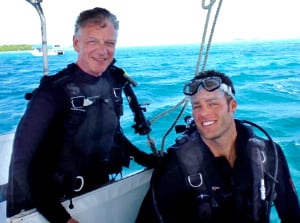
November, 2013
Divers: Rick Crandall; Brett Crandall
this story is about the full range of diving experiences Palau has to offer, including starting the adventure in the tail end of Typhoon Haiyan, the strongest in the history of recorded weather. This is an excursion for experienced divers. I’ve logged many hundreds of dives over 43 years in all kinds of conditions and my son Brett is a certified PADI Rescue Diver (a good guy to have along on challenging dives).
Typhoon Haiyen
Palau is a small group of approximately 200 closely- grouped islands located in the Pacific, a few hundred miles east and south of the Philippines. The area hardest hit by Haiyan, in Palau, was the northernmost island of Kayangel where the storm’s eye passed within about five miles. It destroyed most houses, downed trees and hurt infrastructure. Fortunately residents evacuated before the storm. No deaths were reported as of this writing.
Palau
Palau became an independent Republic in 1994. Previously it was a U.S. Trusteeship when at the end of World War II it was wrested from Japanese occupation. With its 15,000 people living in its 19 states, each being one or more islands. Palau is part of the Pacific Ring of Fire – part volcanic and part limestone. The group of islands is barely a dot on a map.
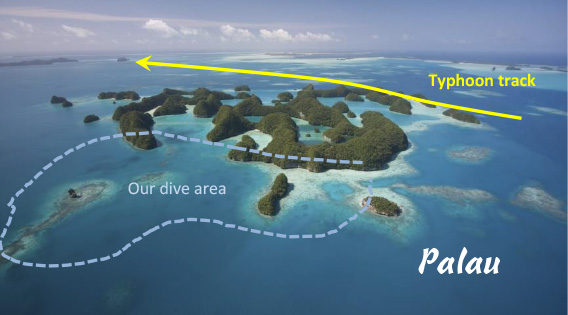
Palau had an indelible role in WW II. In the summer of 1944 American troops invaded the island of Peleliu. The air force bombed Japanese ships and installations to protect the flank of the upcoming invasion of the Philippines just to the northwest by MacArthur. There are still many war relics, tanks, planes, ships and weaponry scattered about that are now against the law to remove. The U. S. used ground troops only on the island of Peleliu but it was so expensive in lost life in a 3 month bloody battle, that afterwards it only used air power and waited until the Japanese surrender before taking over the rest of Palau. Over 10,000 Japanese and 2000 Americans died in that battle.
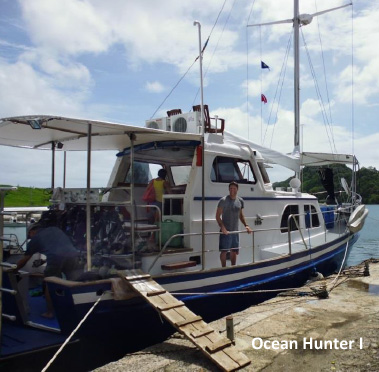
Ocean Hunter I
After 26 hours of flying we arrived at Koror Harbor to board our live-aboard boat, the Ocean Hunter I, that would be our “home” for the week. It is a small boat, 19 meters, but nimble. We were five guest divers (Brett, myself, Liz, a Mexican girl currently a manager in an oil field in Iraq (!); two Asian residents of Hong Kong, Jimmy and Ricky, all experienced divers), plus our Captain Troy, Dive Master Richard and chef Roy).
We arrived after the storm had passed towards the Philippines, but weather was still boisterous and not conducive to the usual first checkout dive in the harbor. We left as soon as we boarded and headed for the western outer reefs where we did our checkout, despite the rain and wind, but we had no problems. Our second dive was a night dive so by the end of the first afternoon we were “proven” to the dive crew.
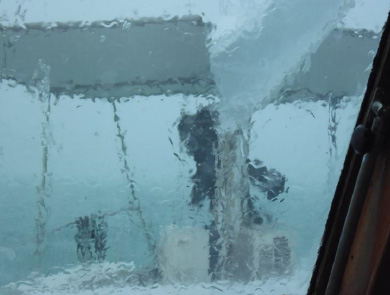
Looking through front window of the boat just before our checkout dive.
Palau is famous for its variety of sharks, mantas, huge schools of fish, turtles, reefs, wrecks, caves, caverns and all mixed with fast current.
The usual warning is:
“beware of advanced sites where you find yourself flying in 3-4 knot currents surrounded by sharks”
Rather than deterring us – that kind of adventure was what we were looking for!
Day 2 featured sunshine and that’s what we had for the rest of the week. We had no contact of any kind with the outside world so we had no idea of the devastation caused by the Typhoon.
The daily program was:
6am: rise, cup of coffee, don our gear and first dive at 6:30am
8 am breakfast
9 – 10 am: second dive
11 – 12 noon third dive
12:30 lunch
2:30 fourth dive
And for those inclined there was a fifth dive at dusk into night starting at about 5:30pm.
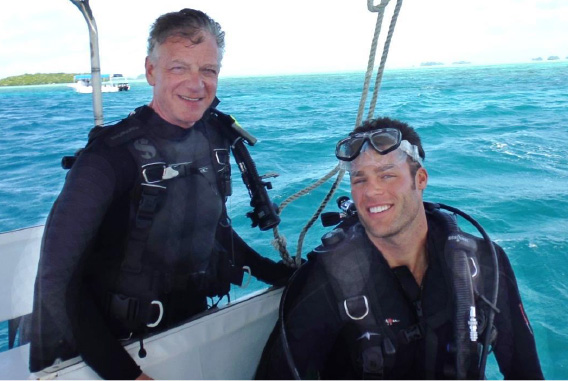
Rick and Brett – suited up and ready to go.
We were both certified for diving with nitrox (32% oxygen) instead of air (21% oxygen) which gave us more bottom time without mandatory decompression, shorter intervals between dives and less fatigue. We were able to get in four dives/day!
The Sharks
It didn’t take long to jump right into the action of Palau diving.
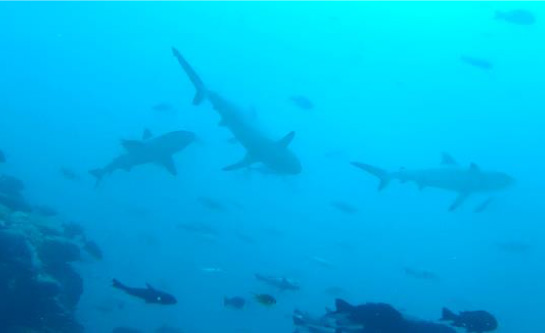
The reefs were populated mainly by two species of sharks, Gray Reef sharks and White Tip sharks. These range from 3 -6’ and usually hunt and feed at dusk and early morning. We did see some hunting in their very distinctive fashion of prowling close to the reefs.
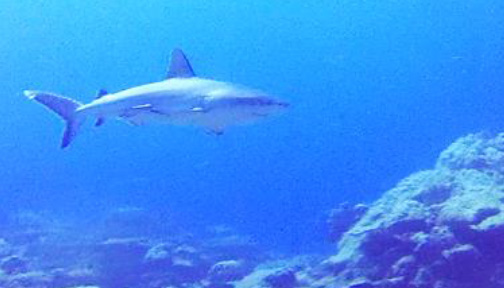
Gray Reef Sharks.
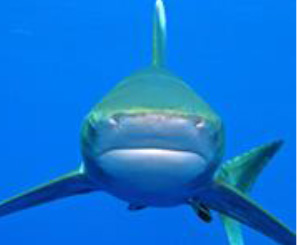
A White Tip, head on. Usually you can shoo them away by exhaling through your regulator – they don’t like the bubbles.
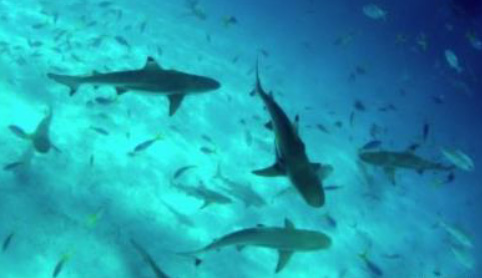
There was no lack of companions. I’m often asked about the danger. There are over 300 types of sharks but only a small number are threatening to man, and even fewer who would attack a scuba diver unless you antagonize them, then all bets are off. Swimmers are more at risk as only parts of their body are visible underwater –legs kicking or arms pushing down which can look like thrashing fish.
The Blue Hole
One of the more famous dive sites in Palau is the Blue Hole – which is an underwater cavern with three “holes” to the outside at various depths. The bottom entry is deep – about 105 -110’ and it’s dark (we brought our lights) but as you rise within, you swim towards the holes for some good silhouette shots.
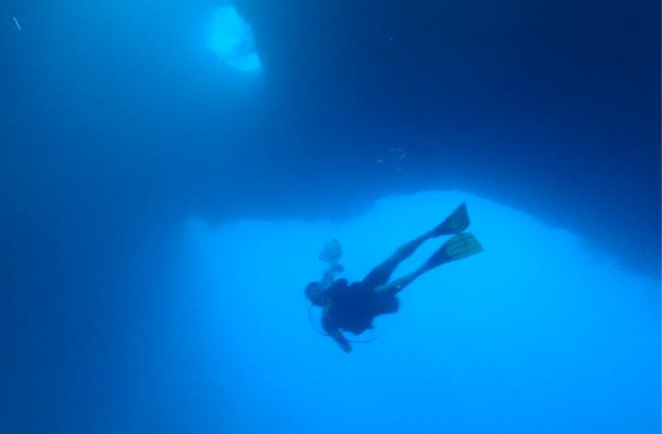
Brett at about 70’. Blue holes behind and above.
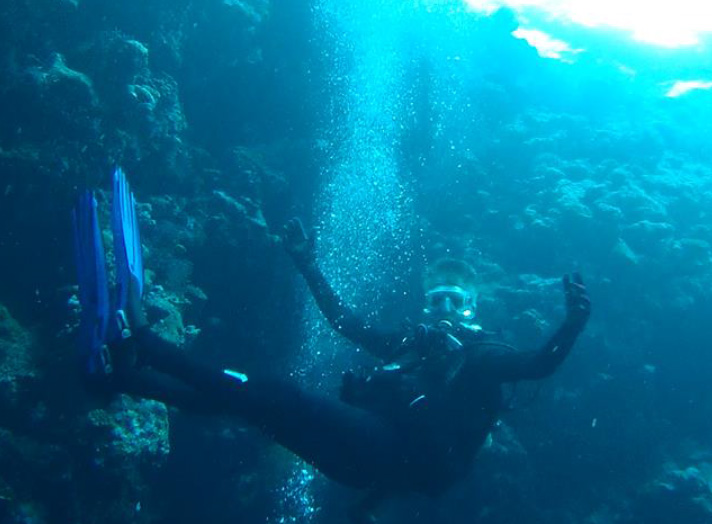
Rick relaxing at about 40’
The Blue Corner
Even more famous than the Blue Hole, and many say the best dive site in the world, is the Blue Corner. It was discovered by a local when exiting the Blue Hole. He decided to swim left, against the current, to a part of the reef that is an actual corner with moderate to strong currents running along the sides of the corner. This unusual setup attracts an amazing variety of fish all very busy in their idiosyncratic moves. The current is strong enough that to stay for more than a minute or two, the island locals invented a Palauan tool called the “reef hook.”
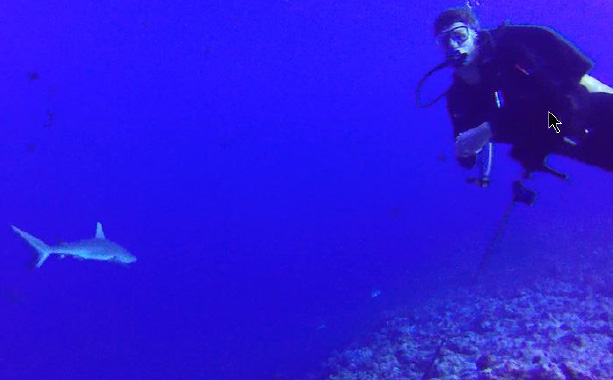
Brett tethered at the Blue Corner
The reef hook is a 6” hook on an 8’ tether you clip to the waist belt of your buoyancy pack. When you get to the “corner” of the reef you find a rock outcropping that you set the hook into. Then fill your pack with a bit of air to float above the reef and you let the current push you taut on your line. Once stable you look around effortlessly. You are essentially in a 3D movie theater with action all around you. Sharks, fish of all kinds, Hawksbill turtles swimming around and even bait balls – huge gatherings of fish all moving in tandem, and much more.
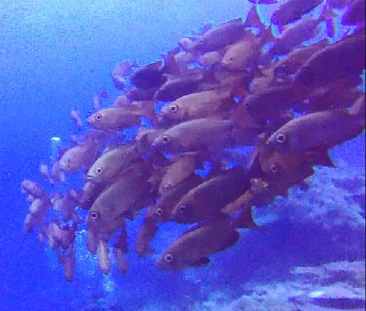
Large schools of fish …
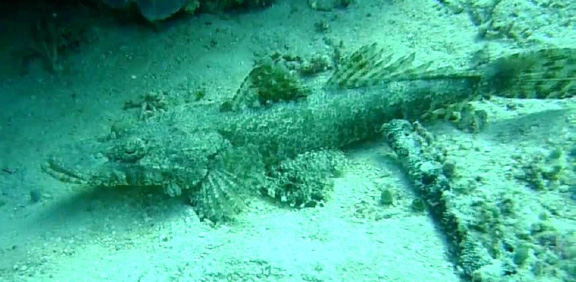
… and my first time seeing a Crocodile fish (from the scorpion fish family with poisonous dorsal spines).
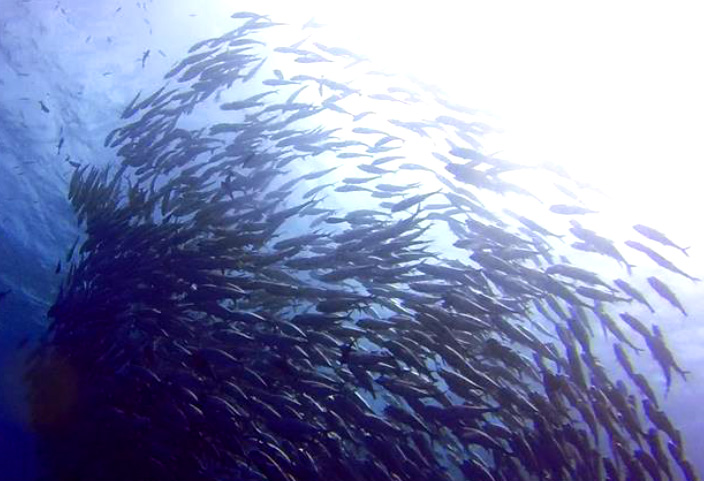
This is a “bait ball” which occurs when small fish swarm in a tightly spherical formation in a last ditch defensive measure when threatened by predators since lone individuals are more likely to be eaten than large groups. However bait balls are also conspicuous and some predators have developed countermeasures which include charging the bait balls with their mouths wide open. This doesn’t always work – the fish are really good at separating and letting the threat pass through.
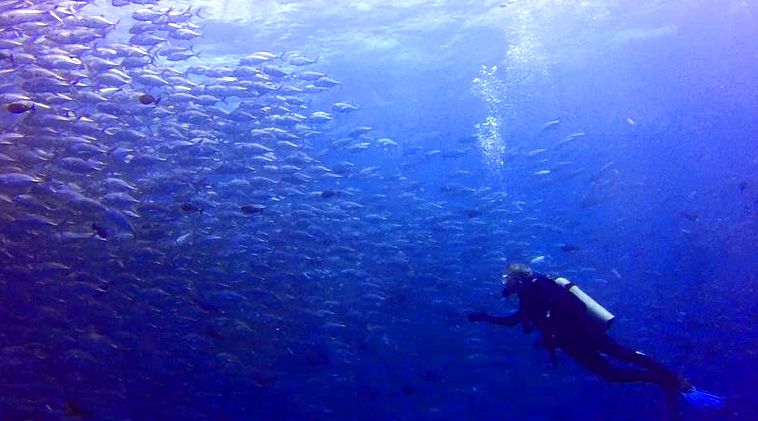
Here I released from the reef and attempted to penetrate a bait ball. The entire mass always knew exactly where I was.
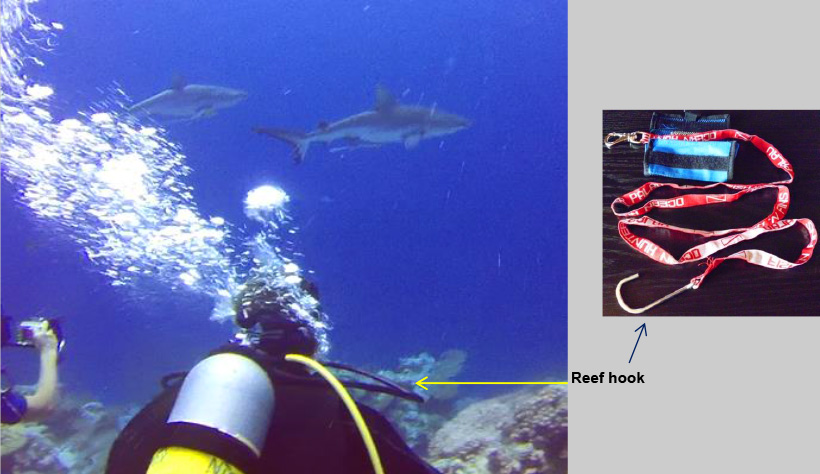
More Blue Corner action.
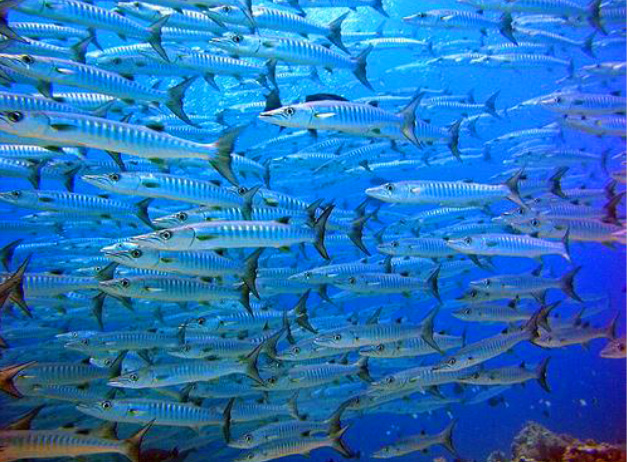
Schooling barracuda
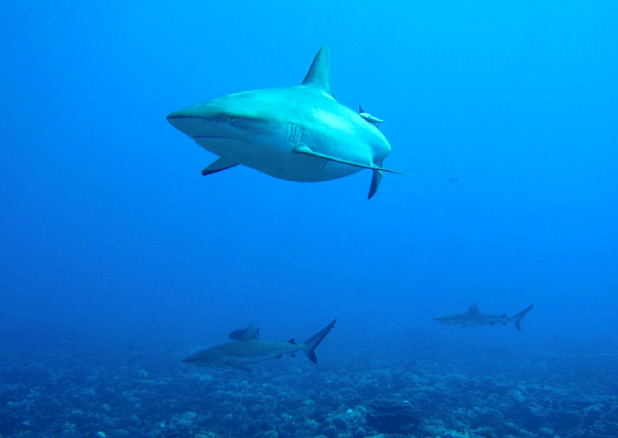
Close encounters of the best kind!
The Napoleon Wrasse
Then there is the comical Napoleon Wrasse – a big fish that reaches 6’ in size. You can see several at the Blue Corner. It has thick fleshy lips like he got too loaded with Botox and has eyes that rotate in a human way – they look right at you. They seem very curious about people and as long as you don’t chase them, they’ll often approach quite close – in fact close enough to get a pet!
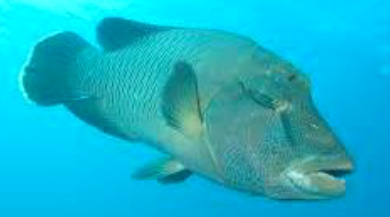
Napoleon Wrasse or Bumphead Wrasse.
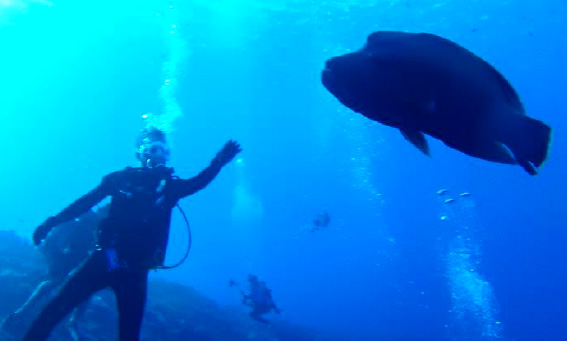
Rick reaching out …
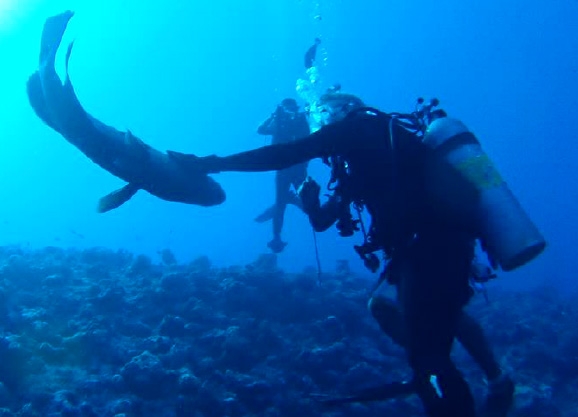
… aw, I think he wanted a scratch behind his ears …
… er where are his ears anyway?
Next up was going to be the Manta Rays. Moving the boat gave us some sunning time.
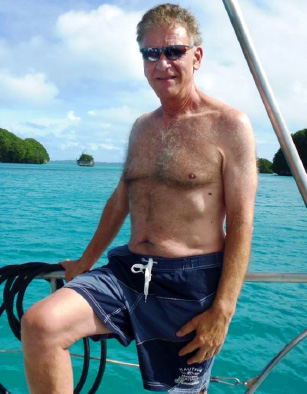
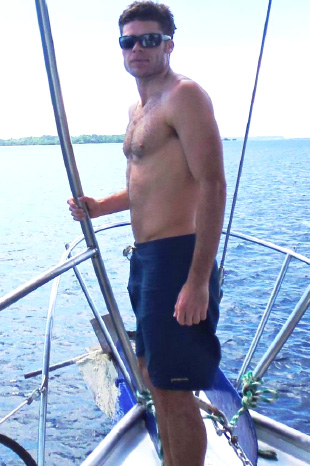

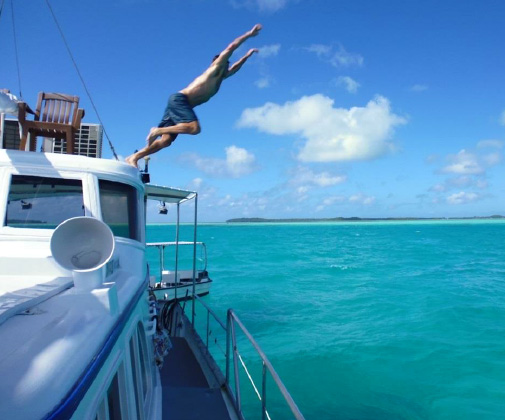
Brett on a busman’s holiday – swimming in-between dives???
The Mantas
In my opinion, the Mantas are the most graceful fish in the sea. Swimming up close with them is a real treat. If you don’t chase them, they will come close and buzz you – very exciting. They can reach 20’ in size – big fish.
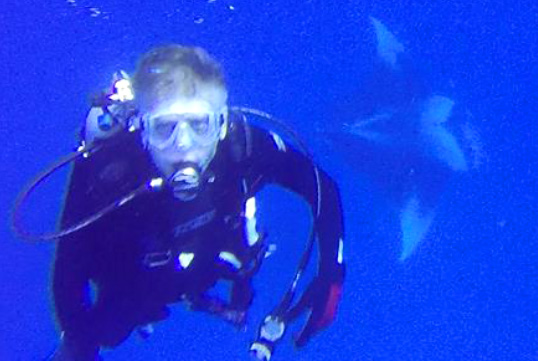
Wazzat behind me???
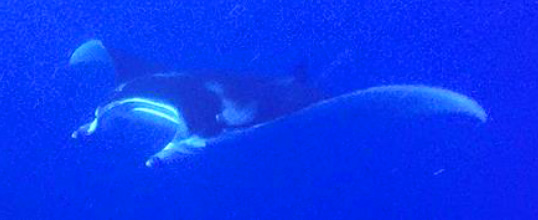
Gorgeous.
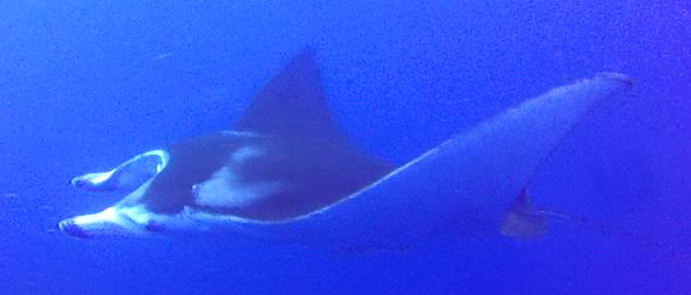
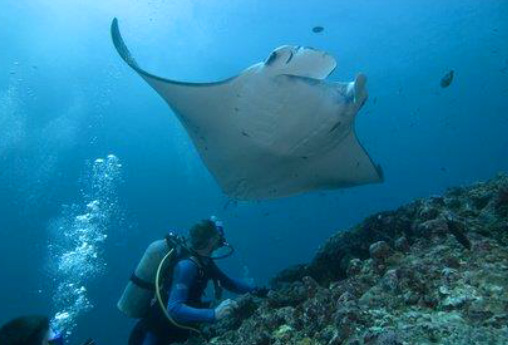
We saw Mantas on at least 4 dives – totally awesome. As big as they are, they feed just on tiny plankton by doing backward somersaults and using their “cheeks” to scoop water into their mouth.
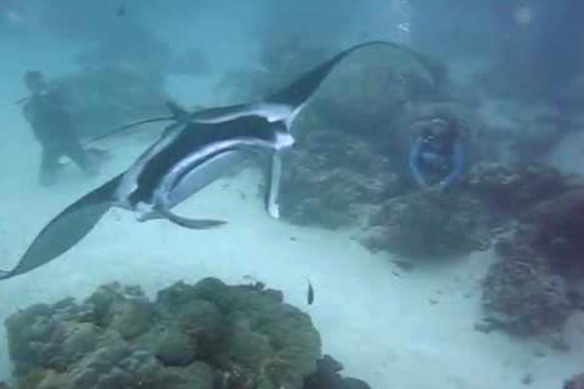
Takes your breath away. That’s Brett kneeling rear left.
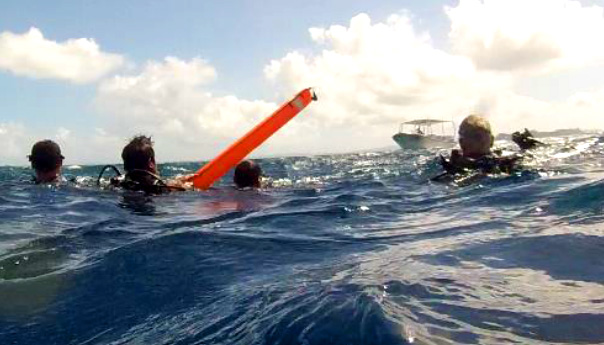
Often to swim with the Mantas we had to swim out to “blue water” i.e. deep. The chase boat had to find us when we came up – so we always had an orange “sausage” we inflated from a tank at the end of a dive, and I had an annoying screeching air whistle connected to my tank pressure that you could hear a long way away.
Oolong Channel
In case we hadn’t had enough current, next up was to dive a long channel between two reefs with current raging. We did a “moving boat” entry (all at once), hit the mouth of the channel and off we went for a ride.
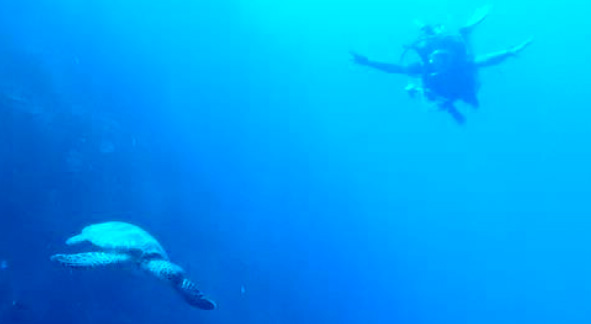
Rick flying in the current with a Hawksbill Turtle. This was super fun as long as the current didn’t shift to an undesirable direction.
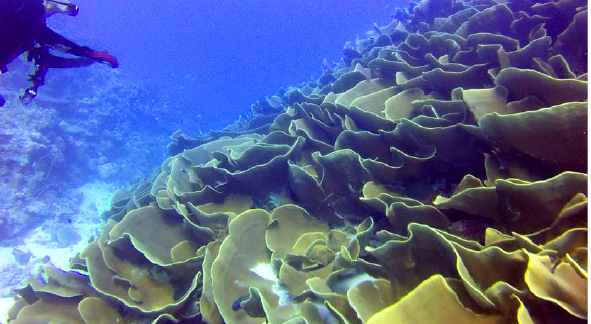
I was stunned flying by the largest bank of lettuce coral I’ve ever seen – and totally unbroken and pristine. This picture shows about 10% of it.
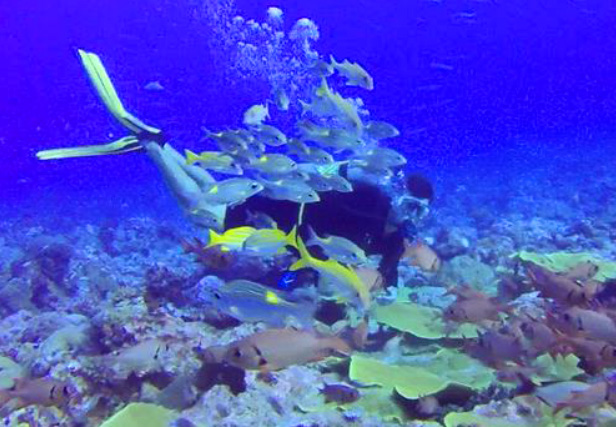
Brett framed by some fish enjoying the ride.
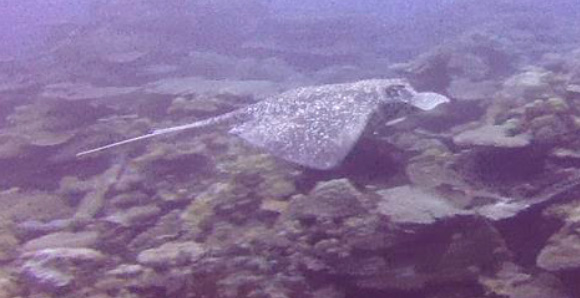
A Marble Ray – the locals call it the Steve Irwin ray. It is the type that stung and killed Steve Irwin. Palau natives would catch these, cut off the latter part of their tails with the barbs, dry it hard and tie it to a bamboo pole for a deadly spear.
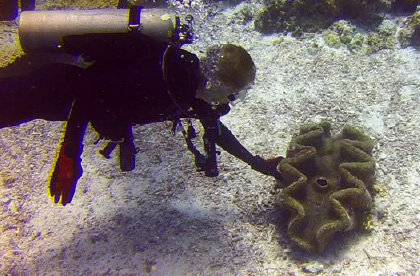
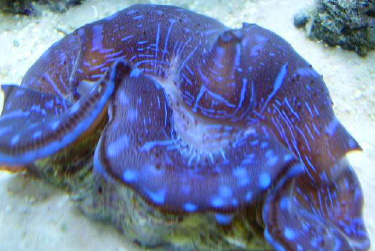
Tridacna gigas – the Giant Clam. Grows to 4’, the largest bivalve in the sea. The blue is the animal.
Coral Gardens in Peleliu
We then hauled to another “state” in Palau, which is just another island, but the famous one of Peleliu where the grueling battle was fought between the Americans and the Japanese. We dove the coral gardens off of the Orange Beach which was the tough landing beach during the war. Their first attempt was at low tide which caused the landing craft to get hung up on this amazing coral. Today the corals were in pristine condition, like fine lace linen.
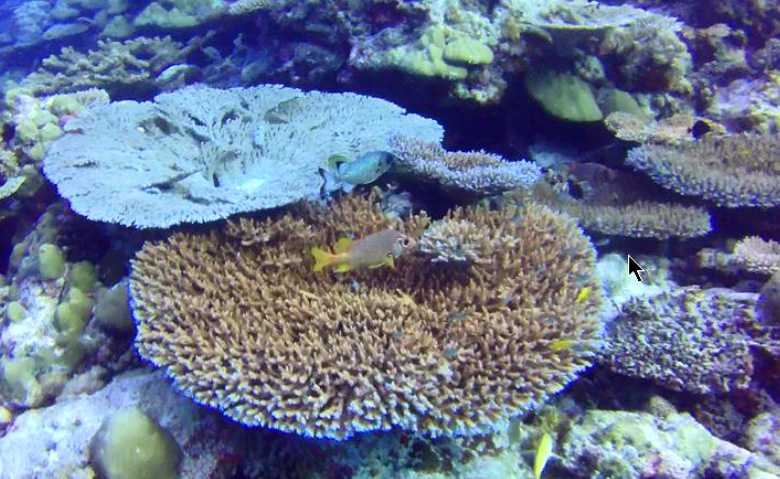
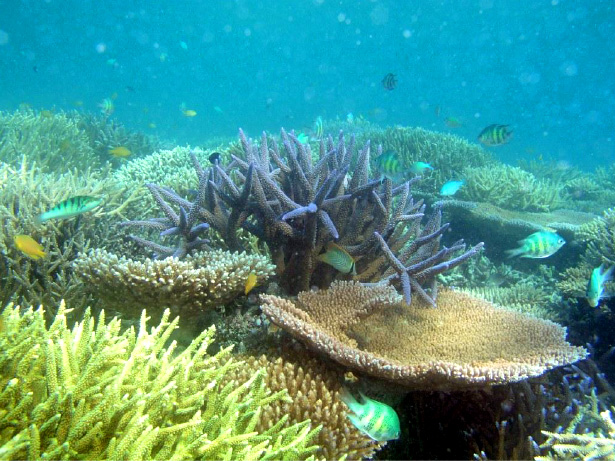
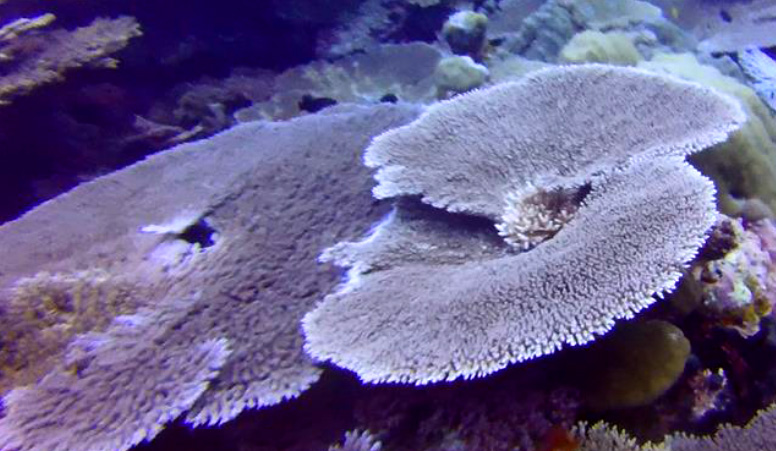
Jellyfish Lake
We’re not done yet – as I said, no other place in the world has the variety of Palau. One of the islands has a strange lake in the middle of the island consisting of brackish water. After reading this you’ll agree this is twilight zone stuff. At some point thousands of years ago the Golden Mastigias jellyfish made it into the lake and thrived. They had no natural enemies there and evolved to have insignificant stingers. There are now an estimated 5 million jellyfish in that lake, so we had to go swim with them.
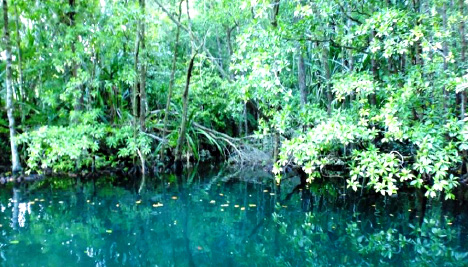
The existence of the lake was popularized by a National Geographic article in 1982.
We boated between some islands to a tiny makeshift dock and had a substantial uphill hike (with snorkels, no scuba tanks) and then down to the lake.
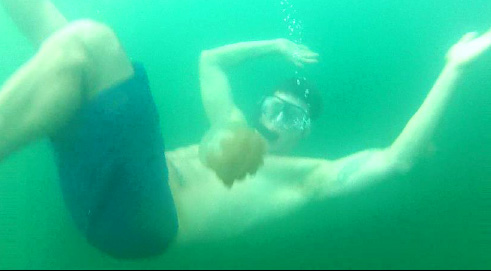
At first, in the darker waters near the edges there was just the occasional jellyfish.
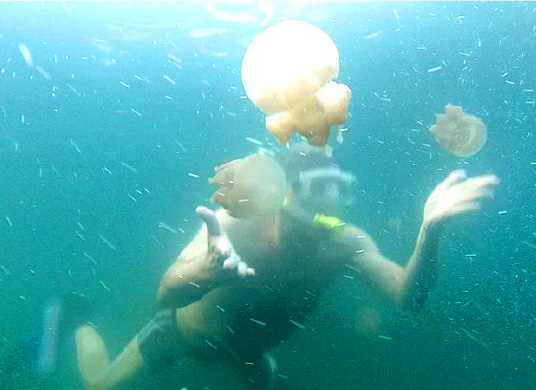
Then as we headed towards the middle, Brett found a few more throbbing away, but not stinging, at least not powerfully enough for us to feel.
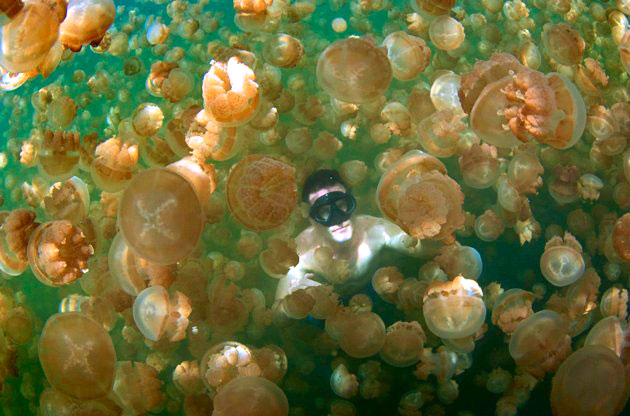
And then in the middle of the lake where the sun was strongest, there were a LOT of jellyfish!
The Life of Pi?
Now here’s where it gets really strange. We learned afterwards that the trees lining the path we hiked to the lake drip a black sap that is poisonous to humans, but with no lawyers around, who needed warnings? It doesn’t stop there – the lake itself only supports life in the first 50’ of depth. From 50’ down to the bottom at 100’ the lake is anoxic – zero oxygen and high concentrations of ammonia and phosphate which are absorbed through the skin and dangerous to living beings. Diving is definitely not allowed and we were hoping we hadn’t free-dived that deep. Are you getting a Life of PI impression? We did.
The Wrecks of Palau
There are literally hundreds of Japanese boat and plane wrecks in the water and buried in the forests of Palau. While on Peleliu we hiked to a wrecked Japanese Zero (a WW II Japanese fighter plane) overgrown with vines. We also ran into a modern-day Australian mine-mitigation company that has been working under government contract for years finding land and sea mines and other munitions still present. The astonishing statistic is that in the past 4 years they have cleared 27,000 munitions of all kinds from the islands and waters. These munitions were left behind by the Japanese 70 years ago – beyond belief.
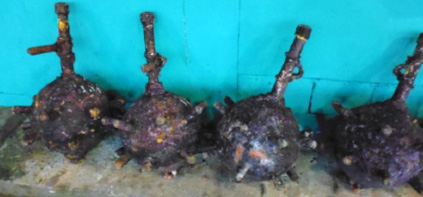
We did two wreck dives – just because they were there. I’ve never found underwater wrecks very interesting, but these were more intact than the usual ones.
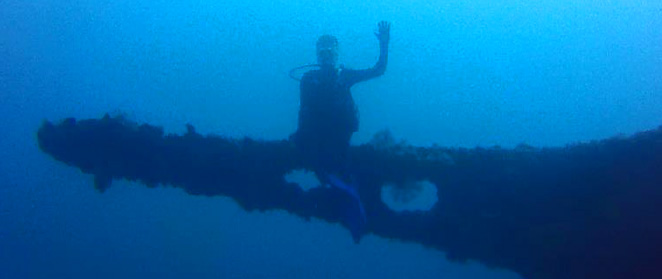
Rick sitting on the prow of a submarine attack boat.
These were deeper dives but not more than 100’
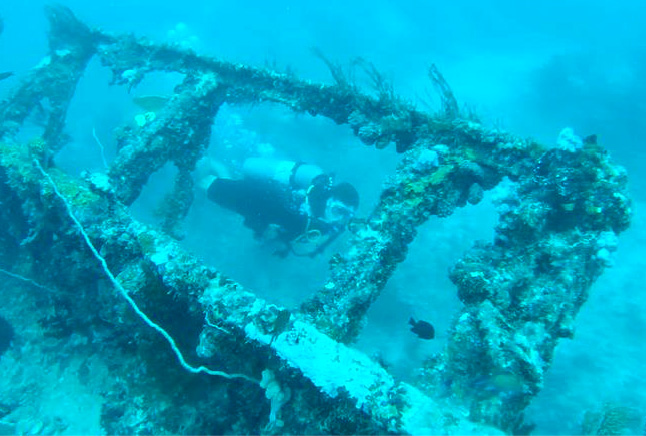
Brett swimming below deck-level of the IRO, a 14 ton supply ship, 470’ long. It lies at 120’ with the deck at 85’
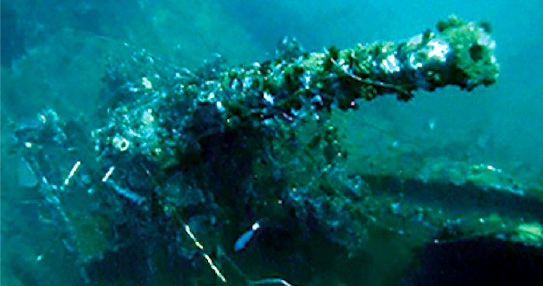
You can still make out the big guns.
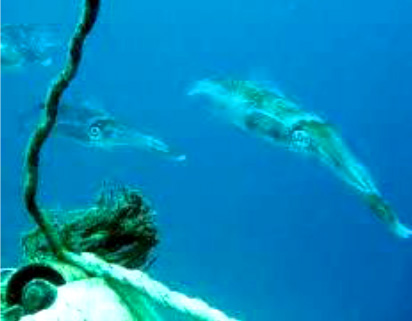
Some squid checking out the IRO with us.
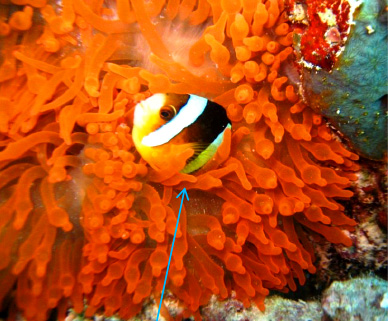
Rare Rose Bubble Anemone that is poisonous to all fish except the Clown fish who take refuge within.
The Dolphins
I once commissioned an authentic northwest Indian totem pole to be carved by Duane Pasco, a famous carver, for our home.
I was extensively interviewed to discover what our family “animal” symbol was. It’s a long story
(see https://www.rickcrandall.net/crandall-family-totem-pole/) but the conclusion was the Dolphin and indeed the Dolphin has appeared often in our lives. Brett and I wondered if we’d get a customary Dolphin visit and sure enough, as we motored along– there they were, still looking out for us. They are totally joyful animals using our wake as a challenge for jumping.
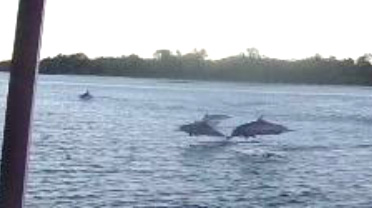
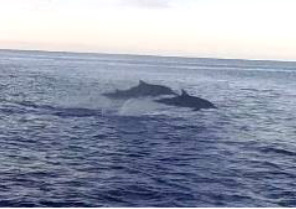
Chandelier Cave Dive
We’ve done no cave diving to speak of, but the Chandelier Cave is a feature of Palau, so we decided not to miss it. We boated to an island, dove down to about 40’ to a cave entrance that led to a system that went right under the island. As we penetrated, we encountered air pockets into which we could surface. This had to be done carefully because in the air cavern above there were stalactites extending downward. Some hung so far down that they extended from the ceiling right down to and several inches into the water. So if you ascended without feeling above, you might have a bad encounter with these rock spikes sticking down into or just above the water surface.
We found four of these underwater small caverns and the air was breathable. We were able to surface in these spooky, totally dark and quiet areas, inflate our buoyancy packs and take our masks off and regulators out. Here are a few photos just using our underwater lights but that’s how strange it all was. Anyone with the slightest amount of claustrophobia or nervousness about diving would have a heart attack in there.
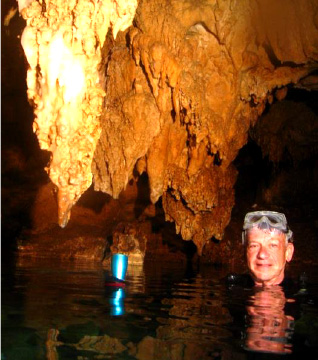
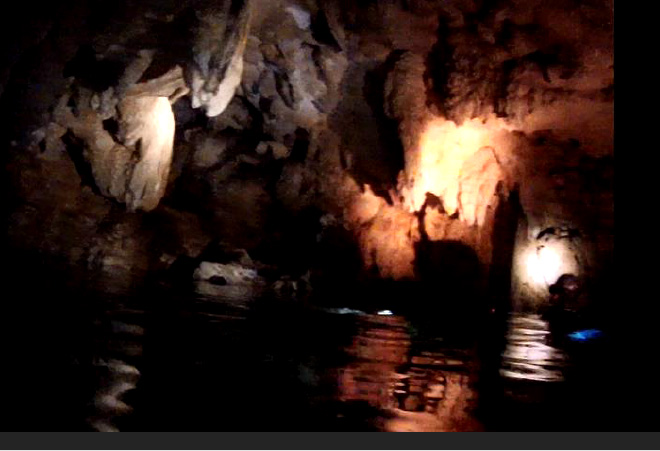
On the way out, when we could see the faint opening in the distance, we all shut our lights off for an out-of-world experience swimming out.
The Mandarin Fish
For our final dive, I’d heard about and seen pictures of the Mandarin Fish and always felt they were unreal. They are intensely colored and look like brilliant Chinese porcelains. They are small fish and shy, but our crew knew of a cove where a shallow dive would take us to where we might, if we were patient, get a shot.
And here he is, unreal!
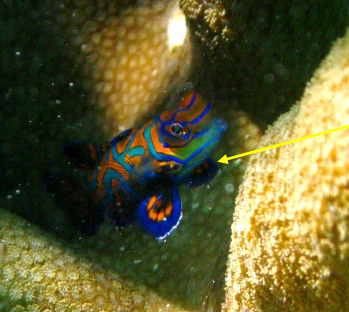
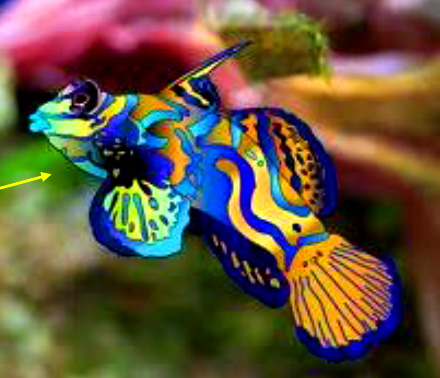
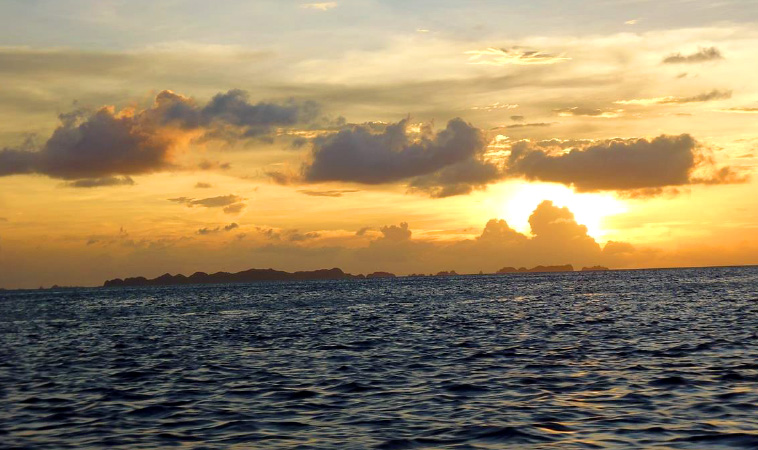
Sunset on the west outer islands of Palau
Finally our adventure was over. It was as good of a dive trip as we’ve ever had, although, our Galapagos dive trip was even more adventurous (see https://www.rickcrandall.net/galapagos-diving-hammerheads-orcas-and-riding-a-whale-shark/ ) We left the outer western reefs of Palau and transitioned back into civilization gradually with five flight legs and 26 hours of travel time. I landed in a snowstorm in Aspen, ready for skiing and Brett returned to his home in Bend.


